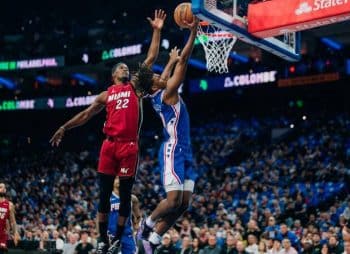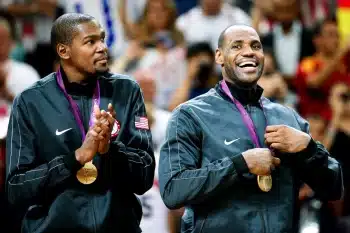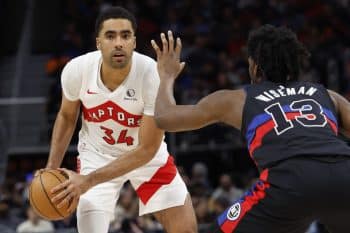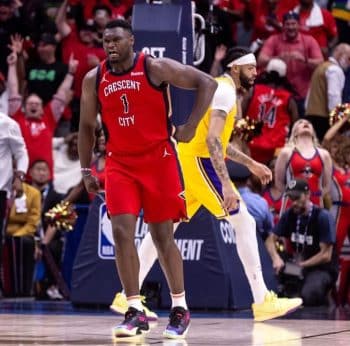NBA
NBA Daily: Six Second-Year Breakout Candidates
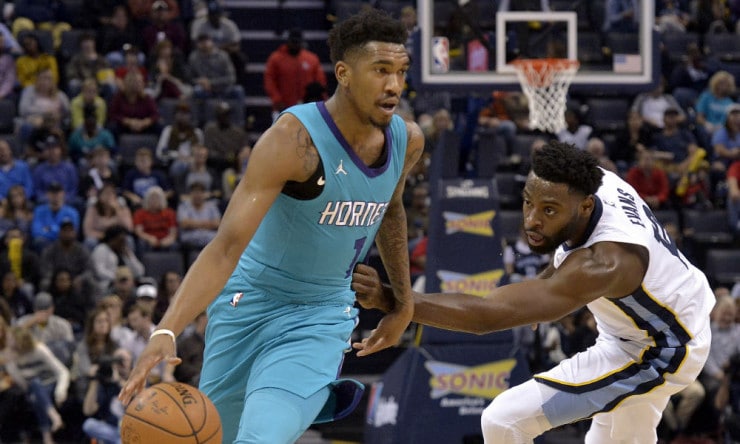
It’s easy to get caught up in searching for the next big thing — and in the NBA, it happens all the time. Between the long-awaited arrival of Ben Simmons and the immediate impact of Jayson Tatum, Donovan Mitchell and Lonzo Ball, among others, it’s been difficult to catch your breath. While this June’s prospective rookies are poised to burst onto the scene, there are plenty of 2017 draftees still looking for their breakthrough as well. Whether they had to deal with lingering injuries, crowded rotations or the G-League, here are six second-year players that should improve by leaps and bounds this upcoming season.
Luke Kennard, Detroit Pistons
Many were disappointed when the Pistons selected Kennard with the No. 12 overall pick in the 2017 NBA Draft, but after a strong end to the season, it looks like the franchise has big plans for the silky shooter. In March, the training wheels came off Kennard and he produced admirably for the playoff-less Pistons. Over 19 contests, the former Blue Devil averaged 11.3 points, 3.5 rebounds and 2.5 assists, reaching the multi-three-pointer mark in seven of those along the way. Even more recently, Detroit had planned to deploy Kennard at point guard during summer league, but a strained knee pushed back those plans for now.
Despite his fluctuating minutes as a rookie, Kennard still made 1.1 three-pointers per game at an impressive 41.5 percent clip. In his final season at Duke in 2016-17, Kennard tallied 19.5 points on 43.8 percent from downtown — so there’s precedent here for the 6-foot-5 guard to join the upper echelon of shooters sooner rather than later. Versatile enough to play three positions, Kennard can flexibly move across the perimeter on both offense and defense — what else could you want from a 22-year-old?
One year later, it’s clear that Detroit is enamored with Kennard, and his role could grow even larger following the arrival of Dwane Casey, the reigning Coach of the Year.
Malik Monk, Charlotte Hornets
In terms of last year’s stacked rookie class, Malik Monk’s false start may have been the most frustrating. Excelling as one of the NCAA’s best scorers, Monk averaged 19.8 points on 39.7 percent from three-point range in his lone season at Kentucky. Deservedly, Monk soared toward the top of draft boards and it was even a surprise when he dropped to Charlotte at No. 11 overall, where fans saw a budding backcourt partner for franchise cornerstone Kemba Walker. Instead, Monk dealt with a few lingering injuries and struggled to get consistent minutes under former head coach Steve Clifford.
All in all, it’d be tough for Monk not to clear his rookie season numbers — 6.7 points, 1.4 assists — but he could absolutely blow them out of the water. Once Monk was freed from rotational hell in March, the streaky shooter settled in and averaged 16.4 points on 42 percent from three-point range — an optimistic sign that the 6-foot-3 shooting guard had begun to turn the corner. Unfortunately, a fractured thumb ended Monk’s stint in Las Vegas this summer after just one game, but should be ready for the season opener. Either way, the Hornets and their bloated payroll will absolutely lean on the second-year assassin in hopes a permanent breakout this fall.
Semi Ojeleye, Boston Celtics
Back in July, Basketball Insiders’ Spencer Davies wrote about how the Celtics’ recent second-round gem plans to build off his successful rookie season. But beyond his strong perimeter defense — an absolute must in Brad Stevens’ rotation — a clear opportunity exists there as well. With Gordon Hayward firmly back in the mix, Ojeleye can focus on honing his craft as the backup small forward. In 15.8 minutes per game last season, Ojeleye averaged just 2.7 points and 2.2 rebounds — but he’s the type of high-energy, high-effort competitor that could carve out a sizable role in Boston.
As a key member of a freakishly athletic second unit that’ll likely include Terry Rozier, Marcus Smart and Daniel Theis, the Celtics will have the chance to suffocate their opponents once more. Certainly, Ojeleye’s 34.6 percent from the field will need work, but his length and flexibility make him an intriguing project under Stevens’ tutelage. Over five summer league games, Ojeleye notched 12.4 points and 4.2 rebounds on 43 percent from the floor — numbers that the Celtics would gladly take from their 23-year-old stopper.
Jordan Bell, Golden State Warriors
It’s tough to envision a 13-game starter for the back-to-back champions as a true breakout candidate — but here we are. With DeMarcus Cousins rehabbing well into the winter as he recovers from an Achilles tear, Bell will get the lion’s share of minutes at center for the foreseeable future. Given his hyper-athletic shot-blocking presence, Bell is the perfect fit for the Warriors’ already-historic scoring side. As a rookie, Bell averaged 4.6 points, 3.6 rebounds, 1.8 assists and a block in only 14.2 minutes per game, but those will all conceivably rise in year two.
Bell, of course, will be a restricted free agent next summer and he’ll be well-chased no matter what happens in 2018-19 — but he could obviously push any prospective payday far higher.
The 6-foot-9 center won’t be tasked with any heavy scoring demands, but as long as he can admirably switch in the pick-and-roll, change shots on defense and catch alley-oops, he’ll be a mainstay in the rotation. Just before Christmas, Bell notched 20 points, 10 rebounds, three assists and one block on 9-for-13 from the floor, fully exhibiting his potential as a highly-efficient contributor. With Zaza Pachulia and David West both moving on this offseason, Bell is one of the league’s most likely breakout candidates.
Dillon Brooks, Memphis Grizzlies
For most of the players on this list, they’re potential-laden prospects just looking for an expanded role — but Dillon Brooks had all that and a bag of chips from opening night. After starting in a staggering 74 games for the lottery-bound Grizzlies as a rookie, Brooks will now try to improve on an impressive start to his career. Brooks, who believes he’ll be one of the class’ best players when it’s all said and done, averaged 11 points, 3.1 rebounds and 1.6 assists in 28.7 minutes per game. As of now, his place in the starting lineup is still yet to be determined, but the retained J.B. Bickerstaff will be pleased to slot Brooks in wherever he’s needed.
Although Brooks will likely never be a superstar, he’s already thrived in a variety of roles for Memphis. From defending future Hall of Famers like Paul George to sharing playmaking responsibilities alongside Tyreke Evans, Brooks has done a little bit of everything for his new franchise. Like the aforementioned Kennard, Brooks took on a bigger scoring responsibility toward the end of the season and responded with a bang. During the Grizzlies’ final six games in April, Brooks tallied a heady 20.8 points, 4.7 rebounds and 4.2 assists — or, in other terms, All-Star-worthy numbers.
Of course, the healthy return of Mike Conley Jr. — as well as the additions of Jaren Jackson Jr., Omri Casspi and Kyle Anderson — means the scoring load won’t fall on Brooks like that too often anymore. Still, Brooks’ versatility, fearlessness and sticky defending will afford him some major opportunities to take the next step in 2018-19.
Isaiah Hartenstein, Houston Rockets
Once upon a time, Hartenstein was projected as a potential first rounder, but he fell to the Rockets at No. 43 overall, where he’d spend an entire season with the Rio Grande Valley Vipers — Houston’s G-League affiliate. Following his upgraded efforts in Las Vegas — 10.3 points, eight rebounds and 2.3 blocks per game — Hartenstein quickly signed a three-year deal this offseason. Although Clint Capela has the center position on lock, Hartenstein will only have to outpace Nene Hilario and Zhou Qi for playing time in the Rockets’ three-point heavy system.
Over 38 contests for Rio Grande, Hartenstein averaged 9.5 points, 6.6 rebounds and 1.1 blocks on 34.3 percent from three-point range. At 20 years old, Hartenstein is raw but his game certainly fits into the modern, unicorn-obsessed mold for an athletic big man. Naturally, Hartenstein is still a work-in-progress, but his portfolio of work over the previous year proved to be enough reason for the Rockets to commit a tiny portion of their future to him.
Every season, eyes are fixated on the new and exciting rookie additions — but we must not forget about the late bloomers either. From lottery selections like Kennard and Monk to second-round grinders like Ojeleye, Bell, Brooks and Hartenstein, the potential sophomore year breakout is always something worth eagerly monitoring. Each situation is fluid and unique, often dependant on injuries, rotations and other mitigating in-season factors — but these are six ready-to-go candidates that could steal the show in 2018-19.
